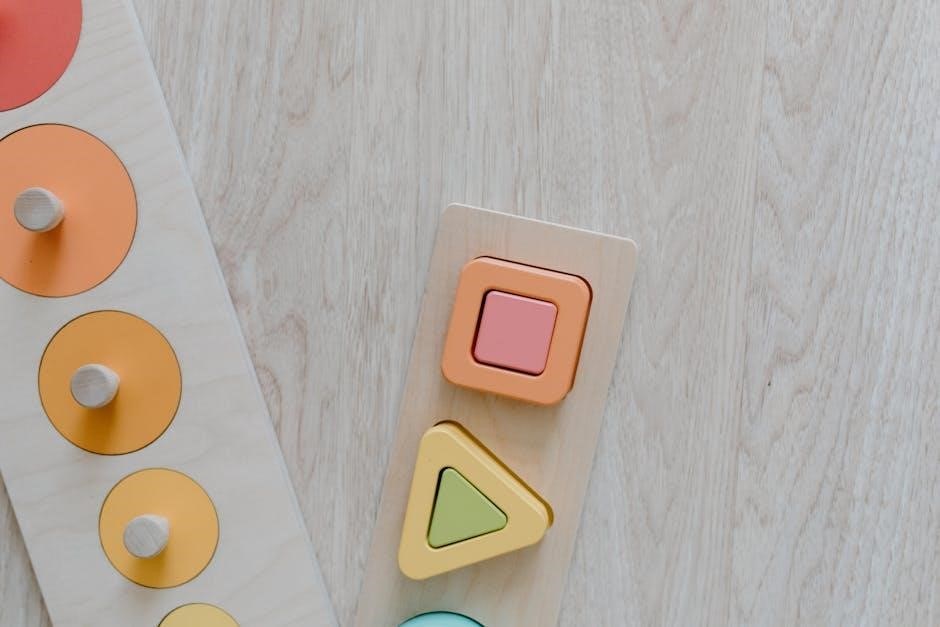Cognitive restructuring is a core technique in CBT, helping individuals identify and challenge negative thought patterns. Worksheets like the cognitive restructuring worksheet PDF guide users through structured exercises to recognize unhelpful thoughts, examine evidence, and reframe them constructively, promoting emotional well-being and behavioral change effectively.
1.1 Definition of Cognitive Restructuring
Cognitive restructuring is a CBT technique that involves identifying and challenging negative or unhelpful thought patterns. It helps individuals recognize how their thoughts influence emotions and behaviors. By examining evidence for and against these thoughts, individuals can reframe them in a more balanced or constructive way. This process is often guided using tools like the cognitive restructuring worksheet PDF, which provides a structured format for documenting and analyzing thoughts. The goal is to replace distorted or irrational beliefs with more realistic ones, leading to improved emotional responses and behaviors. This method is widely used in therapy and self-help practices to promote mental well-being.
1.2 Origin and Purpose of Cognitive Restructuring
Cognitive restructuring, a cornerstone of Cognitive Behavioral Therapy (CBT), was developed by Dr. Aaron Beck in the 1960s. Its primary purpose is to help individuals identify and challenge negative, distorted, or unhelpful thought patterns that contribute to emotional distress. By examining the evidence for and against these thoughts, individuals can reframe them in a more balanced and constructive way. Tools like the cognitive restructuring worksheet PDF are designed to guide this process, providing a structured format for documenting and analyzing thoughts. The ultimate goal is to reduce negative emotions, improve behavioral responses, and enhance overall mental well-being through this evidence-based approach.
1.3 Importance of Cognitive Restructuring in CBT
Cognitive restructuring is a fundamental component of Cognitive Behavioral Therapy (CBT), playing a pivotal role in addressing mental health issues like anxiety, depression, and stress. By targeting negative thought patterns, it empowers individuals to change maladaptive behaviors. Tools such as the cognitive restructuring worksheet PDF provide structured exercises, enabling users to systematically challenge and reframe unhelpful thoughts. This technique fosters self-awareness, emotional regulation, and long-term behavioral change, making it indispensable in CBT interventions. Its effectiveness lies in its practical, evidence-based approach, which has been widely recognized and utilized in therapeutic settings to promote lasting mental health improvement and resilience.

Understanding Cognitive Restructuring Worksheets
Cognitive restructuring worksheets are practical tools used in CBT to help individuals identify and challenge negative thought patterns. They guide users through structured exercises to reframe unhelpful thoughts effectively.
2.1 What is a Cognitive Restructuring Worksheet?
A cognitive restructuring worksheet is a structured tool designed to help individuals systematically challenge and modify unhelpful thought patterns. It typically includes columns for documenting situations, emotions, automatic thoughts, evidence evaluation, and reframed thoughts. These worksheets are widely used in cognitive-behavioral therapy (CBT) to guide users through the process of identifying and altering negative cognitive distortions. By providing a clear and organized format, they enable individuals to track their progress and develop more balanced ways of thinking. Many worksheets are available as downloadable PDFs, offering a convenient resource for self-help and therapeutic settings. Regular use can enhance emotional resilience and reduce distress.
2.2 Key Components of a Cognitive Restructuring Worksheet
A cognitive restructuring worksheet typically includes several key sections to facilitate the thought-challenging process. These components often involve columns or prompts for documenting the situation, the emotion experienced, and the automatic thoughts that arise. Additional sections may focus on identifying evidence for and against the thought, challenging unhelpful beliefs, and restructuring the thought into a more balanced or constructive one. Some worksheets also include space for reflecting on the outcome and planning future actions. These structured elements provide a clear framework for users to systematically work through their thoughts and emotions, making it easier to apply cognitive restructuring techniques effectively. The availability of PDF versions enhances accessibility and convenience for both therapists and individuals.
2.3 Benefits of Using Cognitive Restructuring Worksheets
Cognitive restructuring worksheets offer numerous benefits, particularly in organizing and tracking thoughts, emotions, and behaviors. They provide a structured framework for identifying and challenging unhelpful beliefs, fostering clarity and self-awareness. By systematically examining evidence for and against thoughts, individuals can develop more balanced perspectives. These tools also help users practice mindfulness and emotional regulation, reducing the intensity of negative feelings. Additionally, worksheets serve as practical exercises for applying CBT techniques, making therapy more engaging and effective. Their portability and ease of use, especially in PDF formats, allow individuals to work on their mental health independently, reinforcing progress and accountability over time. This structured approach empowers users to manage anxiety, depression, and stress more effectively.

How to Use a Cognitive Restructuring Worksheet
Using a cognitive restructuring worksheet PDF involves systematically identifying and challenging negative thoughts. Start by describing the situation that triggered emotions. Next, note your emotions and their intensity. Identify automatic thoughts associated with the situation. Then, examine evidence for and against these thoughts, and reframe them into more balanced perspectives. Finally, record the outcome, such as reduced emotional intensity or improved coping strategies. This structured approach helps individuals gain insight, reduce distress, and develop more constructive ways of thinking. Regular use enhances self-awareness and promotes long-term emotional resilience.
In cognitive restructuring worksheet PDF, Step 1 requires detailing the specific situation triggering negative emotions. Clearly describe the event, including setting, people involved, and actions. Be objective, focusing on facts rather than interpretations. This clarity helps in understanding the context behind automatic thoughts. For example, note what happened, where, and who was involved. Avoid vague descriptions; specificity enhances accuracy. Once the situation is clearly outlined, it sets the foundation for analyzing thoughts and emotions. This step is crucial as it provides a concrete reference for subsequent analysis, ensuring the restructuring process is grounded and effective. In Step 2 of the cognitive restructuring worksheet PDF, you assess the emotions triggered by the situation. Identify and label your feelings, such as anxiety, sadness, or anger. Note the intensity of each emotion on a scale (e.g., 0-10). This step helps you understand the emotional impact of the situation. Reflect on how these emotions connect to your thoughts and behaviors. Awareness of your emotional state is crucial for challenging and restructuring thoughts effectively. By documenting your feelings, you gain clarity and prepare for the next steps in the process, such as identifying automatic thoughts and examining evidence. This emotional insight is vital for meaningful change. In Step 3 of the cognitive restructuring worksheet PDF, you pinpoint the automatic thoughts that arise in response to the situation. These thoughts are often rapid, unplanned, and influenced by past experiences. Write down any phrases or beliefs that come to mind, no matter how irrational they may seem. For example, “I’m a failure” or “This will never work.” Be specific and avoid editing your thoughts. This step is about awareness, not judgment. By capturing these thoughts, you can later examine their validity and challenge unhelpful patterns. Accurate identification is key to effective restructuring in subsequent steps. This process promotes self-awareness and sets the stage for meaningful cognitive change. In Step 4 of the cognitive restructuring worksheet PDF, you evaluate the evidence supporting and contradicting your automatic thoughts. This step encourages critical analysis by asking questions like, “What proof do I have that this thought is true?” and “What evidence suggests it might not be true?” Consider past experiences, facts, and alternative perspectives. For example, if your thought is “I always fail,” reflect on times you succeeded. This process helps you assess the validity of your thoughts and identify distortions or biases. By weighing the evidence, you can begin to develop a more balanced and realistic perspective, which is essential for effective cognitive restructuring. This step fosters clarity and prepares you for challenging and reframing unhelpful thoughts. In Step 5 of the cognitive restructuring worksheet PDF, you create a more balanced and realistic thought by challenging the unhelpful one. Start by asking, “What would I say to a friend in this situation?” or “What evidence supports a different perspective?” For example, if your thought is “I always fail,” you might reframe it to “I can learn from this experience and improve next time.” This step involves replacing distorted thoughts with constructive ones, reducing emotional distress and fostering positive change. By practicing this skill, you develop healthier thinking patterns and improve your ability to cope with challenging situations effectively. Cognitive restructuring employs techniques like thought challenging, behavioral experiments, and mindfulness. Worksheets guide these methods to reframe negative thoughts effectively.
Thought challenging and reframing are essential techniques in cognitive restructuring. These methods involve identifying negative thoughts and examining their validity. By challenging unhelpful beliefs and replacing them with balanced, realistic perspectives, individuals can reduce emotional distress. Worksheets like the cognitive restructuring worksheet PDF provide structured exercises to guide this process. Users are prompted to list evidence for and against their thoughts, fostering critical analysis. Reframing then helps transform these insights into constructive, positive beliefs. Regular practice with such tools can lead to lasting cognitive and emotional changes, enhancing overall mental well-being and resilience. Behavioral experiments are a powerful CBT technique that complements cognitive restructuring. They involve testing the validity of negative beliefs through real-world actions. By engaging in specific activities, individuals can challenge unhelpful thoughts and gather evidence to support or refute them. For example, someone fearing social judgment might attend a gathering and observe others’ reactions. Worksheets like the cognitive restructuring worksheet PDF often include sections for planning and reflecting on these experiments. This hands-on approach helps individuals develop more balanced perspectives and reduces anxiety or depression by fostering experiential learning and confidence in challenging situations. Regular practice enhances emotional resilience and promotes lasting change. Cognitive restructuring exercises are practical tools designed to help individuals systematically challenge and modify unhelpful thought patterns. These exercises often involve identifying automatic thoughts, examining evidence for and against them, and developing more balanced perspectives. Worksheets, such as the cognitive restructuring worksheet PDF, provide structured prompts to guide users through these processes. Activities may include thought recording, belief rating, and alternative perspective generation. Regular practice of these exercises can lead to improved emotional regulation, reduced distress, and enhanced problem-solving skills. By reinforcing constructive thinking habits, these exercises empower individuals to manage challenges more effectively and sustain long-term mental well-being. Consistency is key to achieving lasting results. Mindfulness techniques complement cognitive restructuring by fostering non-judgmental awareness of thoughts and emotions. These practices encourage individuals to observe their thoughts without attachment, reducing emotional reactivity. Worksheets like the cognitive restructuring worksheet PDF often incorporate mindfulness exercises to help users develop acceptance and curiosity about their thought patterns. By pairing mindfulness with restructuring, individuals can better recognize automatic thoughts and approach them with a balanced perspective. Regular mindfulness practice enhances self-awareness, making it easier to identify and challenge unhelpful beliefs. This integration supports long-term emotional resilience and a more adaptive response to challenging situations. Mindfulness becomes a powerful tool in sustaining cognitive restructuring efforts. Common challenges in cognitive restructuring include resistance to change, emotional barriers, and unhelpful thinking patterns. Worksheets like the cognitive restructuring worksheet PDF help identify and address these issues systematically. Resistance to change is a common obstacle in cognitive restructuring. Individuals may struggle to let go of familiar thought patterns, even when they are harmful. Worksheets like the cognitive restructuring worksheet PDF provide a structured approach to gradually challenge and replace these thoughts. By systematically examining evidence for and against negative beliefs, individuals can build confidence in new perspectives. It’s important to approach this process with patience, as change takes time. The worksheet serves as a tool to track progress and reinforce new ways of thinking, helping to overcome resistance and foster lasting cognitive shifts. Emotional barriers, such as fear or anxiety, often hinder progress in cognitive restructuring. The cognitive restructuring worksheet PDF helps individuals navigate these challenges by providing a clear framework to identify and address emotional responses. By documenting situations, emotions, and thoughts, users gain insight into patterns that fuel emotional resistance. The worksheet also encourages users to examine evidence for and against distressing thoughts, fostering a more balanced perspective. Over time, this process reduces emotional intensity and enhances the ability to reframe thoughts constructively. Regular practice with the worksheet can lead to improved emotional regulation and resilience, making cognitive restructuring more effective and sustainable. Unhelpful thinking patterns, such as catastrophizing or black-and-white thinking, can significantly impede progress in cognitive restructuring. The cognitive restructuring worksheet PDF is designed to help individuals identify and challenge these patterns systematically. By documenting specific situations and the thoughts associated with them, users can become more aware of their cognitive distortions. The worksheet guides users through examining evidence for and against their thoughts, promoting a more balanced perspective. Through consistent practice, individuals can replace unhelpful patterns with more constructive ways of thinking, leading to improved emotional responses and behaviors. This structured approach enhances self-awareness and facilitates lasting change. Cognitive restructuring is widely applied in managing anxiety, depression, and stress. Worksheets like the cognitive restructuring worksheet PDF help individuals reframe thoughts in real-life scenarios, enhancing emotional resilience and problem-solving skills effectively. Cognitive restructuring is a powerful tool for managing anxiety by addressing negative thought patterns. Worksheets, such as the cognitive restructuring worksheet PDF, guide individuals in identifying situations that trigger anxiety, analyzing emotions, and challenging unhelpful thoughts. By examining evidence for and against these thoughts, individuals can replace them with more balanced perspectives. This process helps reduce anxiety symptoms by fostering rational thinking and emotional regulation. Regular practice with these tools enhances resilience and improves overall mental well-being, making cognitive restructuring a cornerstone of anxiety management in CBT. The structured format of worksheets ensures clarity and effectiveness in applying these techniques. Cognitive restructuring is highly effective in addressing depression by targeting negative thought patterns that exacerbate symptoms. Worksheets like the cognitive restructuring worksheet PDF help individuals identify and challenge unhelpful thoughts associated with depression. By systematically analyzing situations, emotions, and automatic thoughts, individuals can reframe distorted beliefs, reducing feelings of hopelessness and low self-esteem. These tools guide users to examine evidence for and against their thoughts, fostering more balanced perspectives. Regular practice with such worksheets can lead to meaningful behavioral and emotional changes, making cognitive restructuring a fundamental component of CBT for managing depression effectively. The structured approach ensures clarity and progress in therapy. Cognitive restructuring is a powerful tool for managing stress by addressing the negative thoughts that often accompany it. Worksheets like the cognitive restructuring worksheet PDF provide a structured approach to identifying and challenging unhelpful thinking patterns. By analyzing stressful situations, individuals can recognize automatic thoughts, evaluate their validity, and reframe them in a more constructive light. This process reduces emotional reactivity and promotes problem-focused coping strategies. Regular use of these worksheets helps individuals develop resilience, leading to improved stress management and overall well-being. The clear, step-by-step format makes it easier to apply cognitive restructuring techniques effectively in daily life. Cognitive restructuring plays a vital role in resolving interpersonal conflicts by helping individuals identify and challenge negative thought patterns. Worksheets like the cognitive restructuring worksheet PDF guide users to analyze situations, emotions, and automatic thoughts related to conflicts. By examining evidence for and against these thoughts, individuals can reframe unhelpful interpretations and adopt more balanced perspectives. This process reduces emotional reactivity, fosters empathy, and promotes effective communication. Regular use of such tools enhances relationship dynamics by encouraging constructive problem-solving and mutual understanding. The structured format of worksheets makes it easier to apply cognitive restructuring techniques in real-life interpersonal challenges, leading to more harmonious interactions; Cognitive restructuring is a fundamental technique in cognitive-behavioral therapy (CBT) that focuses on identifying and challenging negative thought patterns. It helps individuals recognize how unhelpful thoughts contribute to distressing emotions and behaviors. By examining evidence for and against these thoughts, individuals can reframe them in a more balanced and constructive way. This process fosters emotional resilience and promotes positive behavioral changes. Tools like the cognitive restructuring worksheet PDF provide structured exercises to guide users through this process, making it accessible and practical for personal growth. Regular practice enhances self-awareness and equips individuals with skills to manage challenging situations effectively. For effective cognitive restructuring, utilizing worksheets and PDF resources can enhance understanding and application. The cognitive restructuring worksheet PDF offers structured exercises to identify and challenge negative thoughts, providing a clear framework for emotional and behavioral change. Additional resources include thought diaries, behavioral activation guides, and step-by-step Cognitive Restructuring Exercise sheets. These tools are freely available for download, ensuring accessibility for individuals seeking to manage anxiety, depression, and stress. By incorporating these resources into daily practice, users can systematically reframe unhelpful thoughts, fostering personal growth and emotional well-being. Regular use of these materials can lead to lasting positive changes in mental health management. The future of cognitive restructuring lies in integrating technology and personalization. Digital tools, such as mobile apps and interactive cognitive restructuring worksheet PDF platforms, are expected to enhance accessibility and engagement. These innovations will allow individuals to practice restructuring skills in real-time, receiving immediate feedback. Additionally, advancements in AI could tailor worksheets to individual needs, offering more effective and personalized therapy. Evidence-based research will continue to refine techniques, ensuring that cognitive restructuring remains a cornerstone of mental health management. By leveraging these advancements, cognitive restructuring will evolve into a more dynamic and accessible tool for fostering emotional resilience and well-being.3.1 Step 1: Identify the Situation

3.2 Step 2: Analyze Your Mood and Emotions
3.3 Step 3: Identify Automatic Thoughts
3.4 Step 4: Examine Evidence for and Against the Thought
3.5 Step 5: Challenge and Restructure the Thought

Common Techniques in Cognitive Restructuring
4.1 Thought Challenging and Reframing

4.2 Behavioral Experiments
4.3 Cognitive Restructuring Exercises
4.4 Mindfulness Techniques

Troubleshooting Common Challenges
5.1 Overcoming Resistance to Change
5.2 Managing Emotional Barriers

5.3 Addressing Unhelpful Thinking Patterns

Real-Life Applications of Cognitive Restructuring
6.1 Cognitive Restructuring for Anxiety
6;2 Cognitive Restructuring for Depression
6.3 Cognitive Restructuring for Stress Management
6.4 Cognitive Restructuring in Interpersonal Conflicts
Cognitive restructuring is a powerful tool for managing emotions and thoughts. CBT worksheets and cognitive restructuring worksheet PDFs offer practical exercises to apply these techniques effectively, fostering personal growth and emotional resilience.
7.1 Summary of Cognitive Restructuring
7.2 Recommended Worksheets and PDF Resources
7.3 Future Directions in Cognitive Restructuring
